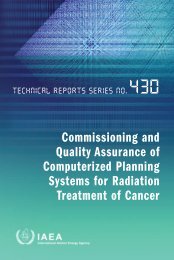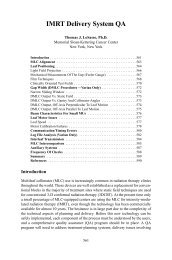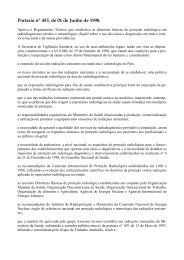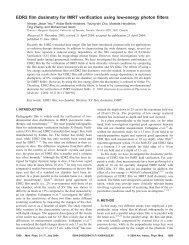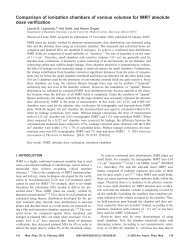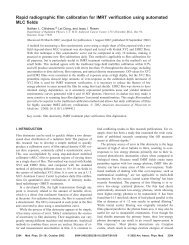intensity-modulated radiotherapy: current status and issues
intensity-modulated radiotherapy: current status and issues
intensity-modulated radiotherapy: current status and issues
Create successful ePaper yourself
Turn your PDF publications into a flip-book with our unique Google optimized e-Paper software.
IMRT: <strong>current</strong> <strong>status</strong> <strong>and</strong> <strong>issues</strong> of interest ● IMRT CWG<br />
895<br />
energy fluence <strong>and</strong> are calibrated by measurements to<br />
obtain the energy fluence per MU produced by the beam<br />
in reference conditions appear to be better suited for<br />
IMRT. However, much work in this area is still required.<br />
IMRT ACCEPTANCE TESTING,<br />
COMMISSIONING, AND QA<br />
In many ways, the <strong>issues</strong> that must be addressed during<br />
acceptance testing <strong>and</strong> commissioning of IMRT planning<br />
<strong>and</strong> delivery systems are analogous to those necessary for<br />
conventional 3D-CRT. 3D-RTP systems, for example, have<br />
in common the requirement for consistently keeping track<br />
of patient-specific information, such as name <strong>and</strong> identification<br />
number, patient image data sets, contours, <strong>and</strong> dose<br />
displays. Both IMRT <strong>and</strong> conventional 3D-RTP systems<br />
calculate 3D dose distributions, <strong>and</strong> the accuracy (magnitude<br />
<strong>and</strong> position) of those dose distributions must be verified<br />
before their clinical use. The American Association of<br />
Physicists in Medicine (AAPM) has recently published a<br />
task group report (TG 53) describing the acceptance testing<br />
<strong>and</strong> commissioning of 3D-RTP systems, <strong>and</strong> the reader is<br />
referred to that report for a discussion of features in common<br />
with IMRT planning systems (164). The acceptance<br />
testing, commissioning, <strong>and</strong> periodic QA effort outlined by<br />
the AAPM TG 53 report is quite extensive, <strong>and</strong> all of that<br />
effort, in principle, applies to IMRT planning systems.<br />
Thus, the amount of work by the medical physicist to<br />
clinically implement an IMRT system must not be underestimated.<br />
Adequate time <strong>and</strong> resources must be made available.<br />
At least two aspects of IMRT distinguish it from conventional<br />
3D-CRT: (1) the optimization process in the planning<br />
phase, <strong>and</strong> (2) the use of non-uniform <strong>and</strong> customized<br />
fluence distributions in the treatment delivery. Computer<br />
optimization algorithms are an entirely new kind of tool to<br />
be added to the treatment planning process <strong>and</strong> will require<br />
the development of new techniques for commissioning,<br />
because, in principle, many inverse planning search algorithms<br />
are based on stochastic methods that may not achieve<br />
exactly the same answer each time, even for the same initial<br />
conditions. Because the development of these optimization<br />
systems is quite new, the commissioning <strong>and</strong> testing techniques<br />
for these systems have not yet been fully developed,<br />
<strong>and</strong> only a cursory discussion of them is possible in this<br />
report. For example, the question of whether the optimization<br />
system always finds the truly best plan cannot be<br />
answered at this time for realistic objective functions that<br />
have multiple minima. This is clearly an issue for which<br />
more research is necessary. However, at worst, nonoptimal<br />
plans will be created, which should be readily recognizable.<br />
The remainder of this section discusses QA for the nonuniform<br />
fluence distributions used in IMRT.<br />
Acceptance testing of the IMRT treatment planning system<br />
As with many validation procedures, the acceptance test<br />
criteria are typically expressed by pass-fail criteria, in which<br />
the system output is compared against criteria that have<br />
been developed <strong>and</strong> accepted by the medical physics community.<br />
For traditional treatment planning systems, comparisons<br />
are typically made between calculated <strong>and</strong> measured<br />
dose distributions using the Van Dyk et al. (165) published<br />
criteria for dose-distribution comparisons that take into account<br />
variations in dose-distribution gradients. For lowdose<br />
gradient regions, the comparison is based on the difference<br />
between the measured <strong>and</strong> calculated doses, with a<br />
criterion of 2% for photon beams along the central axis <strong>and</strong><br />
3% for relative comparisons. In high-dose gradient regions,<br />
the measured dose precision is affected by the uncertainty in<br />
the spatial precision of the measurement. The AAPM TG 53<br />
report (164) generalized <strong>and</strong> exp<strong>and</strong>ed on the concepts in<br />
the Van Dyk work <strong>and</strong> suggested a method for characterizing<br />
the accuracy desired for more complex planning situations.<br />
However, IMRT is even more complex, because<br />
very high-dose gradients may be created by individual <strong>intensity</strong>-<strong>modulated</strong><br />
beams. One method that may help evaluate<br />
this kind of situation is the distance to agreement (165).<br />
For each measurement point, the calculated dose distribution<br />
is examined to determine the distance between a measurement<br />
point <strong>and</strong> the nearest point in the calculated distribution<br />
exhibiting the same dose. Note that care must be<br />
used in applying this concept to individual beam dose<br />
distributions, which are then added up, because the final<br />
dose distribution in the end is the result that must be<br />
confirmed.<br />
Dose-distribution comparisons are typically performed<br />
using manual techniques, such as by examining the dose<br />
distribution on the computer screen or by printing onedimensional<br />
or 2D hard copies of both the calculated <strong>and</strong><br />
the measured distributions. Although these techniques yield<br />
sparse quantitative data, they are often the only comparisons<br />
available to the physicist. Treatment planning tools for<br />
comparisons <strong>and</strong> evaluation of dose calculations, measurements,<br />
<strong>and</strong> other QA activities have been described by<br />
Fraass et al. (166), Harms et al. (167), <strong>and</strong> Low et al. (168);<br />
however, most treatment planning companies have not yet<br />
implemented dose-distribution measurement comparison<br />
software to enable a more thorough evaluation of the calculated<br />
dose distributions. The CWG recommends that<br />
these kinds of quantitative tools be implemented by manufacturers<br />
to help the physicist perform more quantitative<br />
plan comparisons for IMRT <strong>and</strong> 3D-CRT.<br />
In addition to the direct quantitative evaluation of the<br />
IMRT planning system, the commissioning process should<br />
include a determination of the effects of the input parameters<br />
on the optimized dose distribution (169). This evaluation<br />
should be conducted using clinical patient scans <strong>and</strong><br />
target <strong>and</strong> organ-at-risk volumes <strong>and</strong> should be completed<br />
for each treatment site to be used for IMRT. Although a<br />
comprehensive evaluation of the input parameters may not<br />
be possible, an attempt should be made to reduce the available<br />
parameter space to assist treatment planners in developing<br />
the initial treatment plan parameters.<br />
As indicated earlier, no accepted criteria are available as



